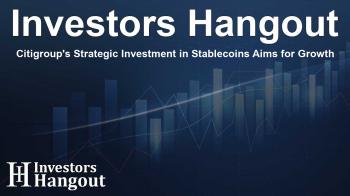Citigroup's Strategic Investment in Stablecoins Aims for Growth

Citigroup's Strategic Move into Stablecoins
Citigroup Inc. (NYSE: C) has made significant strides in the world of stablecoins with an investment in UK-based BVNK. This decision aligns with the growing anticipation within the banking sector regarding the potential for a $1.9 trillion market centered around tokenized currencies. With the finance landscape evolving, stablecoins are emerging as a crucial component of this transformation.
The Implications of Citi’s Investment
This investment was realized through Citi Ventures. BVNK has established itself by managing over $20 billion in transactions annually, working with notable clients such as Worldpay, Flywire, and dLocal. By stepping into this area, Citigroup is solidifying its position in a rapidly expanding market, further emphasizing the increasing relevance of stablecoins for both asset payments and on-chain settlements.
Citi's Commitment to Innovation
As articulated by Arvind Purushotham, head of Citi Ventures, the traction that stablecoins are gaining indicates a promising future for on-chain settlement processes. Although Citi has not disclosed the financial specifics of this agreement, the move exemplifies the bank's shift towards embracing innovative financial technologies.
The Shift from Crypto Speculation to Stablecoin Utility
This shift for Citi marks a departure from previous skepticism towards speculative digital currencies, focusing instead on the practical applications of dollar tokenization. CEO Jane Fraser revealed that Citi plans to explore issuing its own Citi-branded stablecoin, with the intention of streamlining global transactions and enhancing digital asset custody.
Forecasting the Future of Stablecoins
Citi's internal analytics team has recently updated its stablecoin issuance projections, estimating that the market could reach a staggering $1.9 trillion by 2030. This forecast underscores the monumental potential for widespread institutional adoption and the transformation of traditional banking practices.
Current Market Landscape
By comparison, the global supply of stablecoins currently totals approximately $289.3 billion, primarily being driven by leading players like Tether (USDT) and USD Coin (USDC). Other financial giants like Goldman Sachs and JPMorgan are also advancing into this realm, with JPM Coin reportedly facilitating billions in wholesale transfers daily.
The Impact of the GENIUS Act
Recently, the GENIUS Act has emerged as a pivotal piece of legislation affecting stablecoins in the U.S. The act allows banks to more easily issue and manage stablecoins under the oversight of the Treasury Department, promising to integrate stablecoins more deeply into the U.S. payment system.
The Regulatory Framework Ahead
This legislative development formalizes the issuance, backing, and regulation of stablecoins by traditional banks, assisting in alleviating concerns regarding compliance with securities laws. As consultations progress, stablecoins are expected to play a substantial role in the payments ecosystem by the anticipated implementation phase around 2026.
Understanding Why This Matters
The emergence of stablecoins as a critical component of modern finance signifies a monumental shift in how currencies are utilized globally. Citigroup's investment in BVNK reaffirms the notion that dollar-backed tokens are likely to become the preferred medium for international monetary transfers.
A New Era of Financial Intermediaries
The anticipated $1.9 trillion market projection does not merely indicate expansion but suggests a wholesale transformation of transactional value transfer across nations and banks. Should Wall Street rally around this emerging model, stablecoins could transition from niche assets to the foundational underpinning of the global financial architecture, innovating traditional banking methodologies.
Frequently Asked Questions
What is the significance of Citigroup's investment in stablecoins?
Citigroup's investment signifies its commitment to embracing innovative financial technologies and positioning itself competitively within the evolving landscape of digital finance.
How does the GENIUS Act influence stablecoin regulation?
The GENIUS Act streamlines the regulatory process for banks to issue stablecoins, enabling them to engage in this market while complying with federal oversight.
What potential does the stablecoin market hold by 2030?
The stablecoin market is projected to reach $1.9 trillion by 2030, reflecting substantial institutional adoption and changed banking practices.
Which companies are leading the stablecoin market?
Currently, Tether (USDT) and USD Coin (USDC) lead the stablecoin market, managing significant portions of the total supply valued at roughly $289.3 billion.
How might stablecoins impact global transactions?
Stablecoins are positioned to be the default medium for cross-border transactions, potentially revolutionizing the way money is transferred internationally and reducing reliance on traditional networks such as SWIFT.
About The Author
Contact Kelly Martin privately here. Or send an email with ATTN: Kelly Martin as the subject to contact@investorshangout.com.
About Investors Hangout
Investors Hangout is a leading online stock forum for financial discussion and learning, offering a wide range of free tools and resources. It draws in traders of all levels, who exchange market knowledge, investigate trading tactics, and keep an eye on industry developments in real time. Featuring financial articles, stock message boards, quotes, charts, company profiles, and live news updates. Through cooperative learning and a wealth of informational resources, it helps users from novices creating their first portfolios to experts honing their techniques. Join Investors Hangout today: https://investorshangout.com/
The content of this article is based on factual, publicly available information and does not represent legal, financial, or investment advice. Investors Hangout does not offer financial advice, and the author is not a licensed financial advisor. Consult a qualified advisor before making any financial or investment decisions based on this article. This article should not be considered advice to purchase, sell, or hold any securities or other investments. If any of the material provided here is inaccurate, please contact us for corrections.

